Health Sector Careers, Structure, Legislation and Workforce Report
VerifiedAdded on 2020/06/05
|7
|1902
|217
Report
AI Summary
This report provides an overview of various aspects of the health sector. It begins by exploring two distinct career paths: nursing and service management, detailing their responsibilities, required skills, and educational qualifications. The report then discusses the structure of health service provision in the UK, followed by an analysis of the roles and responsibilities of social care organizations like the Social Care Institute of Excellence (SCIE) and a care home (Birchwood). Furthermore, it examines the impact of legislation, such as the Health and Safety Act 1974 and the Care Standards Act 2000, on social care provisions. The report also highlights the importance of workforce development through training, mentoring, and continuous improvement. Finally, it provides examples of multi-disciplinary working, such as partnerships with the NHS, to address organizational strengths and weaknesses and improve service delivery. The conclusion summarizes the key findings, emphasizing the significance of compliance with healthcare legislation, the essential requirements for various health sector professions, and the benefits of collaboration between organizations.
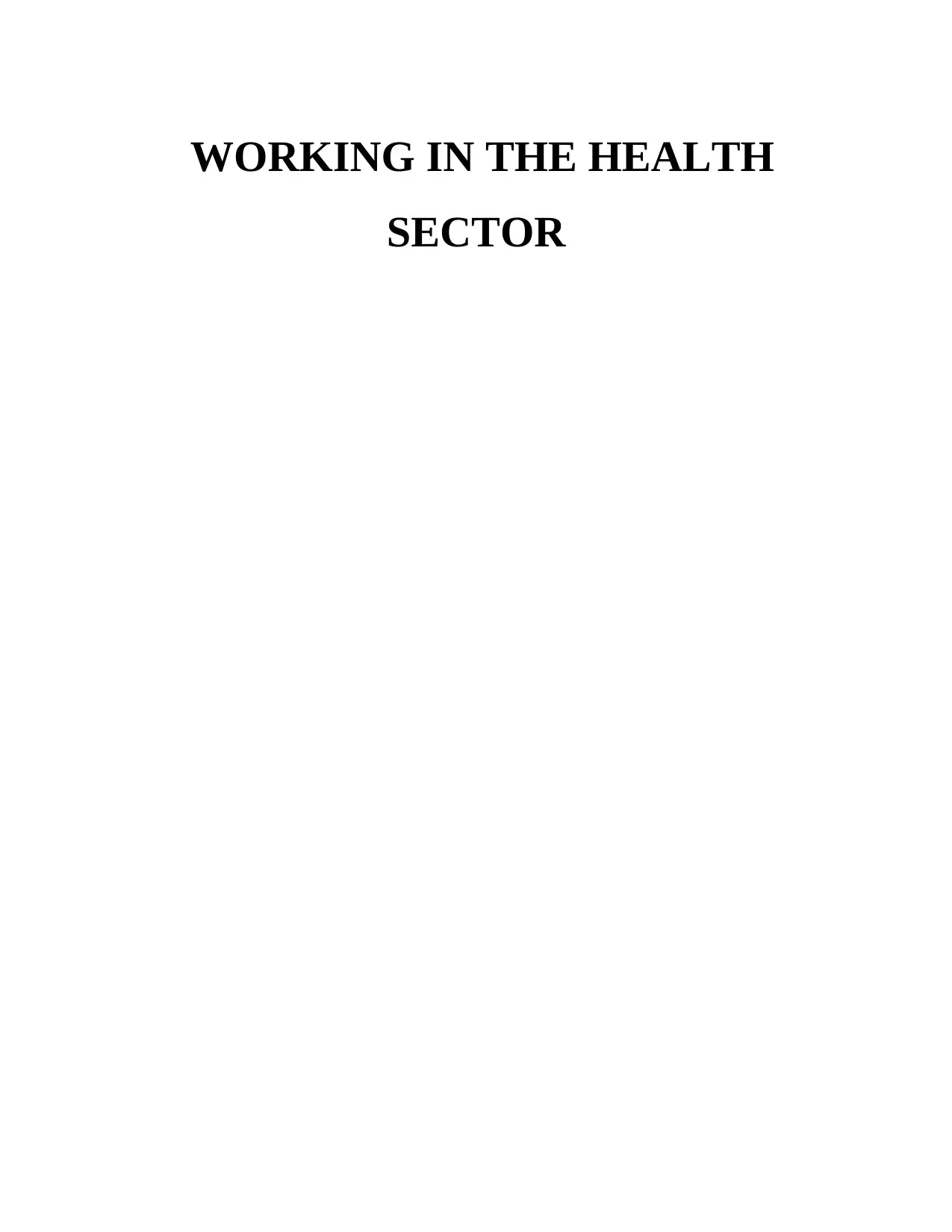
WORKING IN THE HEALTH
SECTOR
SECTOR
Paraphrase This Document
Need a fresh take? Get an instant paraphrase of this document with our AI Paraphraser
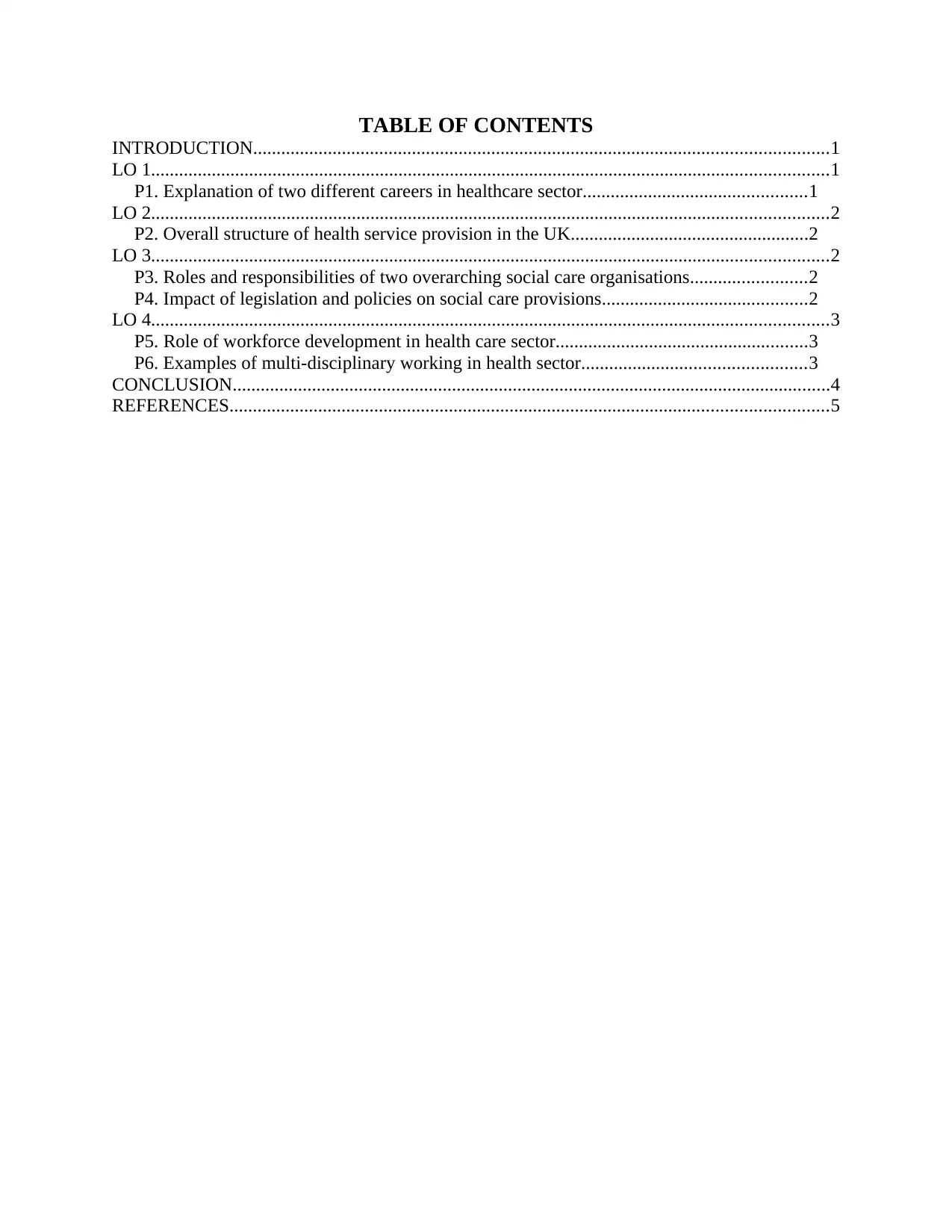
TABLE OF CONTENTS
INTRODUCTION...........................................................................................................................1
LO 1.................................................................................................................................................1
P1. Explanation of two different careers in healthcare sector................................................1
LO 2.................................................................................................................................................2
P2. Overall structure of health service provision in the UK...................................................2
LO 3.................................................................................................................................................2
P3. Roles and responsibilities of two overarching social care organisations.........................2
P4. Impact of legislation and policies on social care provisions............................................2
LO 4.................................................................................................................................................3
P5. Role of workforce development in health care sector......................................................3
P6. Examples of multi-disciplinary working in health sector................................................3
CONCLUSION................................................................................................................................4
REFERENCES................................................................................................................................5
INTRODUCTION...........................................................................................................................1
LO 1.................................................................................................................................................1
P1. Explanation of two different careers in healthcare sector................................................1
LO 2.................................................................................................................................................2
P2. Overall structure of health service provision in the UK...................................................2
LO 3.................................................................................................................................................2
P3. Roles and responsibilities of two overarching social care organisations.........................2
P4. Impact of legislation and policies on social care provisions............................................2
LO 4.................................................................................................................................................3
P5. Role of workforce development in health care sector......................................................3
P6. Examples of multi-disciplinary working in health sector................................................3
CONCLUSION................................................................................................................................4
REFERENCES................................................................................................................................5

INTRODUCTION
Healthcare organisation are known for providing facilities like medical treatment and
social service to the public (Pestoff, 2012). Birchwood care home is an organisation who is
working in Newbury, UK. Although, they are providing treatment of various diseases but
Alzheimer's, hearing impairment are some of their specialities. This assignment will discuss
about the skills needed in couple of career options which are available in health sector. Structure
of health service provision in the United Kingdom will also become a part of this report.
Accountability of two overarching healthcare organisations will be included in this file. Few
examples of multi-disciplinary working will be explained at the end as well.
LO 1
P1. Explanation of two different careers in healthcare sector
Opportunities of career growth in healthcare industry are enormous. Earlier, people only
knew about two professions in this sector i.e. doctors and nurse. But now, there are different
kinds of jobs, and requirements for two of them is as follows:
Nurse – Nurses are responsible for taking care of patients. It is their duty to follow the
instructions given by doctors like timely giving medicine to service user, recording their body
temperature, etc. In order to enter in this profession, one needs to get bachelor degree in nursing.
It also includes the practical training where students are taken to hospital for teaching and giving
them real life experience. Some care homes recruit candidates who have pursed diploma course
in nursing. Beside educational qualifications, nurses also require skills regarding how to move
and handle stretcher. They should have basic knowledge about medicines and nutrition because it
is an integral part of their job (Williams, 2012). Communication skill is another key requirement
for this profession. Nurse should have a clear understanding about how to talk with patients and
their attendants. Post operation care, recording blood pressure, pulse rate, temperatures are other
duties which comes under job description of nurses.
Service manager – In healthcare sector, various organisations do tries to provide better
facilities in order to earn more profit and increase popularity of the institution. Their main aim is
to resolve problems of service users and assure well-being of public. If someone wants to
become service manager then he/she must possess all the information about doctors and nursing
staff. In terms of education, master's degree in health sciences or business administration is
required. Another key skill needed to become health service manager is knowledge about
1
Healthcare organisation are known for providing facilities like medical treatment and
social service to the public (Pestoff, 2012). Birchwood care home is an organisation who is
working in Newbury, UK. Although, they are providing treatment of various diseases but
Alzheimer's, hearing impairment are some of their specialities. This assignment will discuss
about the skills needed in couple of career options which are available in health sector. Structure
of health service provision in the United Kingdom will also become a part of this report.
Accountability of two overarching healthcare organisations will be included in this file. Few
examples of multi-disciplinary working will be explained at the end as well.
LO 1
P1. Explanation of two different careers in healthcare sector
Opportunities of career growth in healthcare industry are enormous. Earlier, people only
knew about two professions in this sector i.e. doctors and nurse. But now, there are different
kinds of jobs, and requirements for two of them is as follows:
Nurse – Nurses are responsible for taking care of patients. It is their duty to follow the
instructions given by doctors like timely giving medicine to service user, recording their body
temperature, etc. In order to enter in this profession, one needs to get bachelor degree in nursing.
It also includes the practical training where students are taken to hospital for teaching and giving
them real life experience. Some care homes recruit candidates who have pursed diploma course
in nursing. Beside educational qualifications, nurses also require skills regarding how to move
and handle stretcher. They should have basic knowledge about medicines and nutrition because it
is an integral part of their job (Williams, 2012). Communication skill is another key requirement
for this profession. Nurse should have a clear understanding about how to talk with patients and
their attendants. Post operation care, recording blood pressure, pulse rate, temperatures are other
duties which comes under job description of nurses.
Service manager – In healthcare sector, various organisations do tries to provide better
facilities in order to earn more profit and increase popularity of the institution. Their main aim is
to resolve problems of service users and assure well-being of public. If someone wants to
become service manager then he/she must possess all the information about doctors and nursing
staff. In terms of education, master's degree in health sciences or business administration is
required. Another key skill needed to become health service manager is knowledge about
1
⊘ This is a preview!⊘
Do you want full access?
Subscribe today to unlock all pages.

Trusted by 1+ million students worldwide
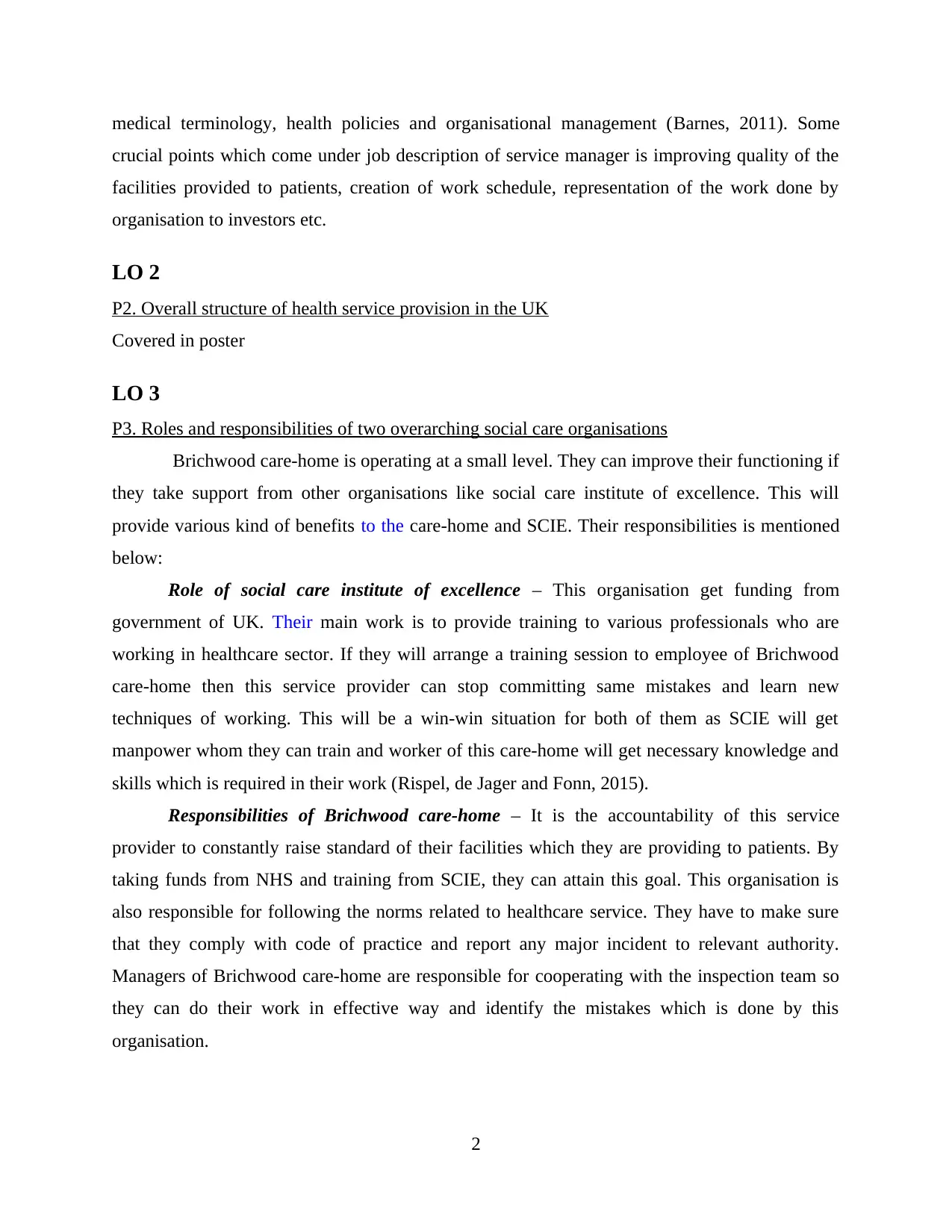
medical terminology, health policies and organisational management (Barnes, 2011). Some
crucial points which come under job description of service manager is improving quality of the
facilities provided to patients, creation of work schedule, representation of the work done by
organisation to investors etc.
LO 2
P2. Overall structure of health service provision in the UK
Covered in poster
LO 3
P3. Roles and responsibilities of two overarching social care organisations
Brichwood care-home is operating at a small level. They can improve their functioning if
they take support from other organisations like social care institute of excellence. This will
provide various kind of benefits to the care-home and SCIE. Their responsibilities is mentioned
below:
Role of social care institute of excellence – This organisation get funding from
government of UK. Their main work is to provide training to various professionals who are
working in healthcare sector. If they will arrange a training session to employee of Brichwood
care-home then this service provider can stop committing same mistakes and learn new
techniques of working. This will be a win-win situation for both of them as SCIE will get
manpower whom they can train and worker of this care-home will get necessary knowledge and
skills which is required in their work (Rispel, de Jager and Fonn, 2015).
Responsibilities of Brichwood care-home – It is the accountability of this service
provider to constantly raise standard of their facilities which they are providing to patients. By
taking funds from NHS and training from SCIE, they can attain this goal. This organisation is
also responsible for following the norms related to healthcare service. They have to make sure
that they comply with code of practice and report any major incident to relevant authority.
Managers of Brichwood care-home are responsible for cooperating with the inspection team so
they can do their work in effective way and identify the mistakes which is done by this
organisation.
2
crucial points which come under job description of service manager is improving quality of the
facilities provided to patients, creation of work schedule, representation of the work done by
organisation to investors etc.
LO 2
P2. Overall structure of health service provision in the UK
Covered in poster
LO 3
P3. Roles and responsibilities of two overarching social care organisations
Brichwood care-home is operating at a small level. They can improve their functioning if
they take support from other organisations like social care institute of excellence. This will
provide various kind of benefits to the care-home and SCIE. Their responsibilities is mentioned
below:
Role of social care institute of excellence – This organisation get funding from
government of UK. Their main work is to provide training to various professionals who are
working in healthcare sector. If they will arrange a training session to employee of Brichwood
care-home then this service provider can stop committing same mistakes and learn new
techniques of working. This will be a win-win situation for both of them as SCIE will get
manpower whom they can train and worker of this care-home will get necessary knowledge and
skills which is required in their work (Rispel, de Jager and Fonn, 2015).
Responsibilities of Brichwood care-home – It is the accountability of this service
provider to constantly raise standard of their facilities which they are providing to patients. By
taking funds from NHS and training from SCIE, they can attain this goal. This organisation is
also responsible for following the norms related to healthcare service. They have to make sure
that they comply with code of practice and report any major incident to relevant authority.
Managers of Brichwood care-home are responsible for cooperating with the inspection team so
they can do their work in effective way and identify the mistakes which is done by this
organisation.
2
Paraphrase This Document
Need a fresh take? Get an instant paraphrase of this document with our AI Paraphraser
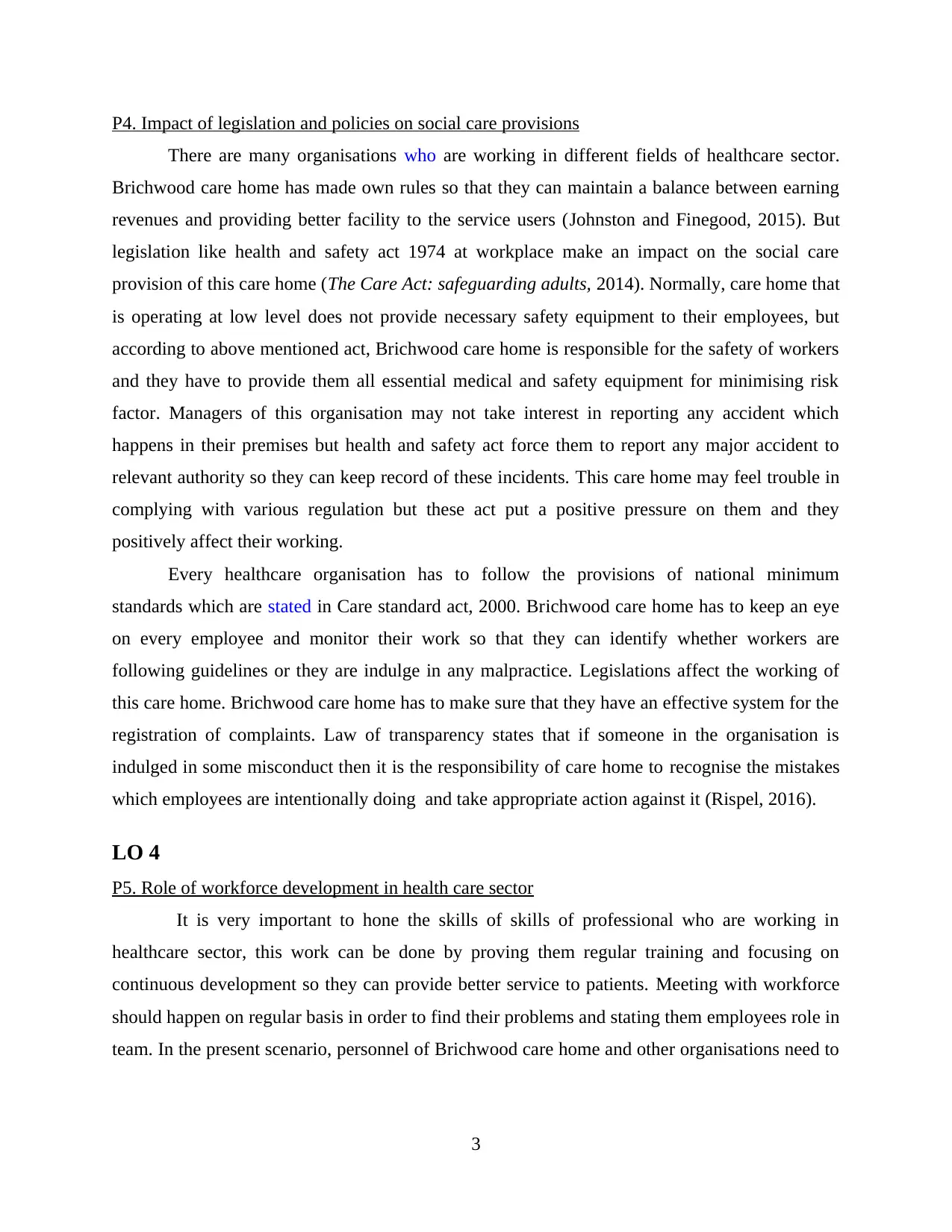
P4. Impact of legislation and policies on social care provisions
There are many organisations who are working in different fields of healthcare sector.
Brichwood care home has made own rules so that they can maintain a balance between earning
revenues and providing better facility to the service users (Johnston and Finegood, 2015). But
legislation like health and safety act 1974 at workplace make an impact on the social care
provision of this care home (The Care Act: safeguarding adults, 2014). Normally, care home that
is operating at low level does not provide necessary safety equipment to their employees, but
according to above mentioned act, Brichwood care home is responsible for the safety of workers
and they have to provide them all essential medical and safety equipment for minimising risk
factor. Managers of this organisation may not take interest in reporting any accident which
happens in their premises but health and safety act force them to report any major accident to
relevant authority so they can keep record of these incidents. This care home may feel trouble in
complying with various regulation but these act put a positive pressure on them and they
positively affect their working.
Every healthcare organisation has to follow the provisions of national minimum
standards which are stated in Care standard act, 2000. Brichwood care home has to keep an eye
on every employee and monitor their work so that they can identify whether workers are
following guidelines or they are indulge in any malpractice. Legislations affect the working of
this care home. Brichwood care home has to make sure that they have an effective system for the
registration of complaints. Law of transparency states that if someone in the organisation is
indulged in some misconduct then it is the responsibility of care home to recognise the mistakes
which employees are intentionally doing and take appropriate action against it (Rispel, 2016).
LO 4
P5. Role of workforce development in health care sector
It is very important to hone the skills of skills of professional who are working in
healthcare sector, this work can be done by proving them regular training and focusing on
continuous development so they can provide better service to patients. Meeting with workforce
should happen on regular basis in order to find their problems and stating them employees role in
team. In the present scenario, personnel of Brichwood care home and other organisations need to
3
There are many organisations who are working in different fields of healthcare sector.
Brichwood care home has made own rules so that they can maintain a balance between earning
revenues and providing better facility to the service users (Johnston and Finegood, 2015). But
legislation like health and safety act 1974 at workplace make an impact on the social care
provision of this care home (The Care Act: safeguarding adults, 2014). Normally, care home that
is operating at low level does not provide necessary safety equipment to their employees, but
according to above mentioned act, Brichwood care home is responsible for the safety of workers
and they have to provide them all essential medical and safety equipment for minimising risk
factor. Managers of this organisation may not take interest in reporting any accident which
happens in their premises but health and safety act force them to report any major accident to
relevant authority so they can keep record of these incidents. This care home may feel trouble in
complying with various regulation but these act put a positive pressure on them and they
positively affect their working.
Every healthcare organisation has to follow the provisions of national minimum
standards which are stated in Care standard act, 2000. Brichwood care home has to keep an eye
on every employee and monitor their work so that they can identify whether workers are
following guidelines or they are indulge in any malpractice. Legislations affect the working of
this care home. Brichwood care home has to make sure that they have an effective system for the
registration of complaints. Law of transparency states that if someone in the organisation is
indulged in some misconduct then it is the responsibility of care home to recognise the mistakes
which employees are intentionally doing and take appropriate action against it (Rispel, 2016).
LO 4
P5. Role of workforce development in health care sector
It is very important to hone the skills of skills of professional who are working in
healthcare sector, this work can be done by proving them regular training and focusing on
continuous development so they can provide better service to patients. Meeting with workforce
should happen on regular basis in order to find their problems and stating them employees role in
team. In the present scenario, personnel of Brichwood care home and other organisations need to
3
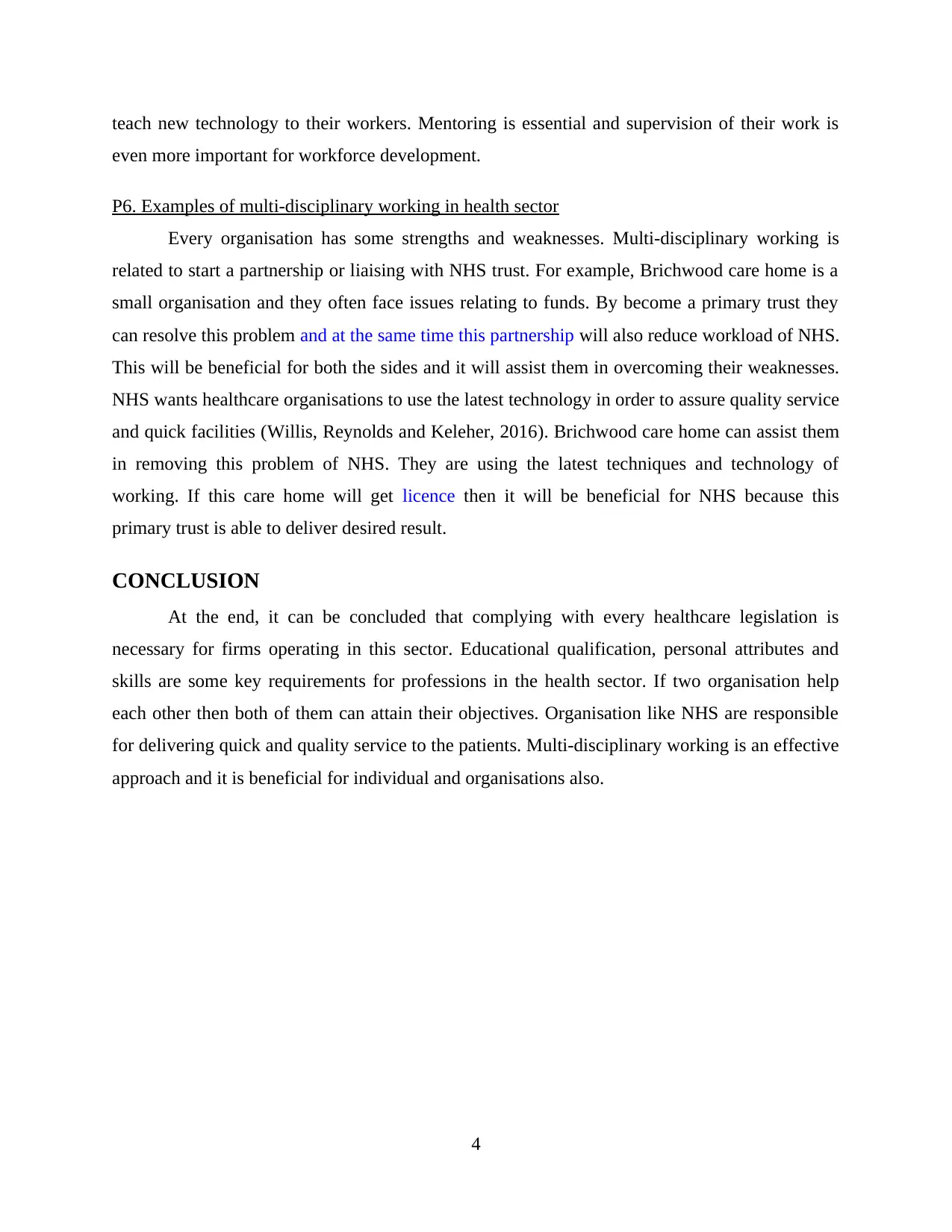
teach new technology to their workers. Mentoring is essential and supervision of their work is
even more important for workforce development.
P6. Examples of multi-disciplinary working in health sector
Every organisation has some strengths and weaknesses. Multi-disciplinary working is
related to start a partnership or liaising with NHS trust. For example, Brichwood care home is a
small organisation and they often face issues relating to funds. By become a primary trust they
can resolve this problem and at the same time this partnership will also reduce workload of NHS.
This will be beneficial for both the sides and it will assist them in overcoming their weaknesses.
NHS wants healthcare organisations to use the latest technology in order to assure quality service
and quick facilities (Willis, Reynolds and Keleher, 2016). Brichwood care home can assist them
in removing this problem of NHS. They are using the latest techniques and technology of
working. If this care home will get licence then it will be beneficial for NHS because this
primary trust is able to deliver desired result.
CONCLUSION
At the end, it can be concluded that complying with every healthcare legislation is
necessary for firms operating in this sector. Educational qualification, personal attributes and
skills are some key requirements for professions in the health sector. If two organisation help
each other then both of them can attain their objectives. Organisation like NHS are responsible
for delivering quick and quality service to the patients. Multi-disciplinary working is an effective
approach and it is beneficial for individual and organisations also.
4
even more important for workforce development.
P6. Examples of multi-disciplinary working in health sector
Every organisation has some strengths and weaknesses. Multi-disciplinary working is
related to start a partnership or liaising with NHS trust. For example, Brichwood care home is a
small organisation and they often face issues relating to funds. By become a primary trust they
can resolve this problem and at the same time this partnership will also reduce workload of NHS.
This will be beneficial for both the sides and it will assist them in overcoming their weaknesses.
NHS wants healthcare organisations to use the latest technology in order to assure quality service
and quick facilities (Willis, Reynolds and Keleher, 2016). Brichwood care home can assist them
in removing this problem of NHS. They are using the latest techniques and technology of
working. If this care home will get licence then it will be beneficial for NHS because this
primary trust is able to deliver desired result.
CONCLUSION
At the end, it can be concluded that complying with every healthcare legislation is
necessary for firms operating in this sector. Educational qualification, personal attributes and
skills are some key requirements for professions in the health sector. If two organisation help
each other then both of them can attain their objectives. Organisation like NHS are responsible
for delivering quick and quality service to the patients. Multi-disciplinary working is an effective
approach and it is beneficial for individual and organisations also.
4
⊘ This is a preview!⊘
Do you want full access?
Subscribe today to unlock all pages.

Trusted by 1+ million students worldwide
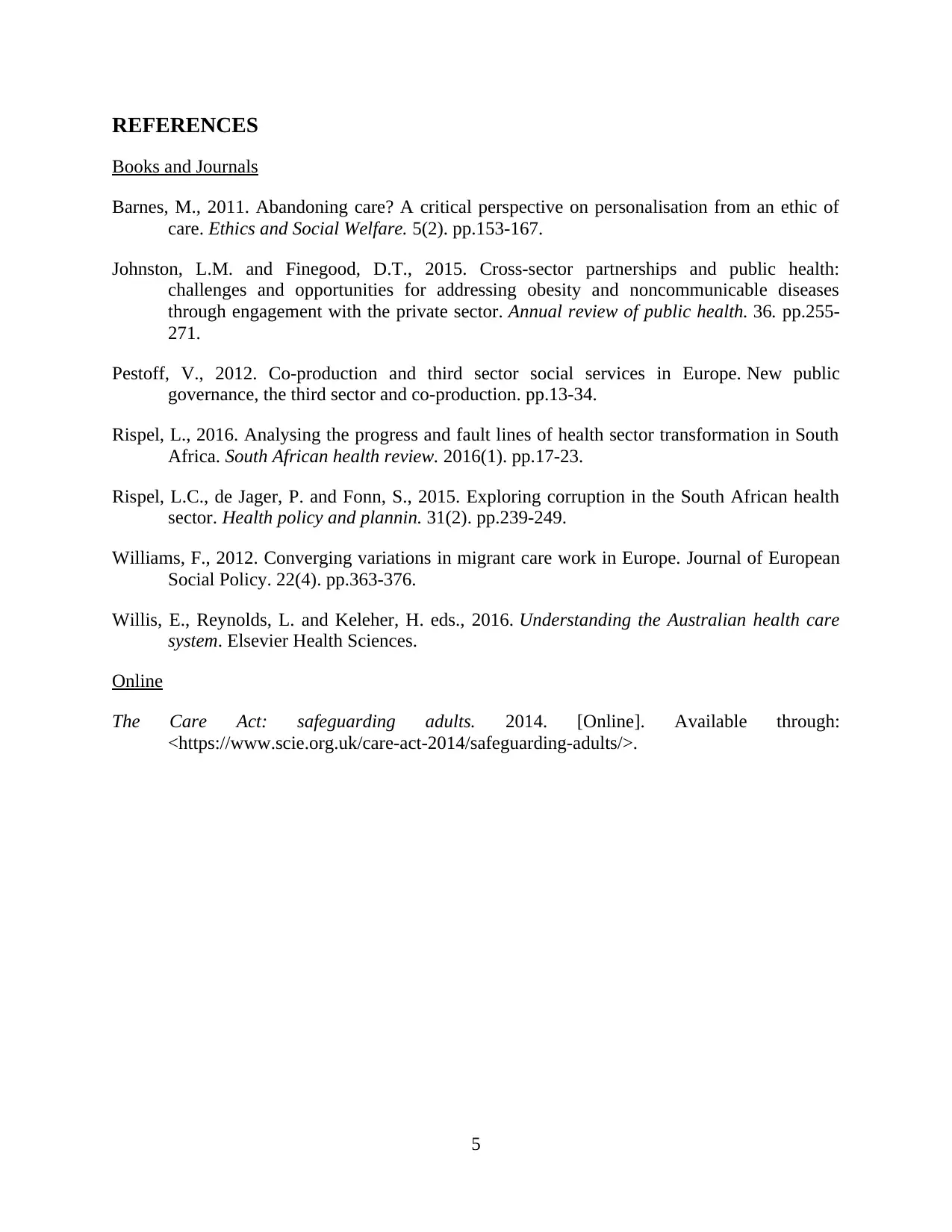
REFERENCES
Books and Journals
Barnes, M., 2011. Abandoning care? A critical perspective on personalisation from an ethic of
care. Ethics and Social Welfare. 5(2). pp.153-167.
Johnston, L.M. and Finegood, D.T., 2015. Cross-sector partnerships and public health:
challenges and opportunities for addressing obesity and noncommunicable diseases
through engagement with the private sector. Annual review of public health. 36. pp.255-
271.
Pestoff, V., 2012. Co-production and third sector social services in Europe. New public
governance, the third sector and co-production. pp.13-34.
Rispel, L., 2016. Analysing the progress and fault lines of health sector transformation in South
Africa. South African health review. 2016(1). pp.17-23.
Rispel, L.C., de Jager, P. and Fonn, S., 2015. Exploring corruption in the South African health
sector. Health policy and plannin. 31(2). pp.239-249.
Williams, F., 2012. Converging variations in migrant care work in Europe. Journal of European
Social Policy. 22(4). pp.363-376.
Willis, E., Reynolds, L. and Keleher, H. eds., 2016. Understanding the Australian health care
system. Elsevier Health Sciences.
Online
The Care Act: safeguarding adults. 2014. [Online]. Available through:
<https://www.scie.org.uk/care-act-2014/safeguarding-adults/>.
5
Books and Journals
Barnes, M., 2011. Abandoning care? A critical perspective on personalisation from an ethic of
care. Ethics and Social Welfare. 5(2). pp.153-167.
Johnston, L.M. and Finegood, D.T., 2015. Cross-sector partnerships and public health:
challenges and opportunities for addressing obesity and noncommunicable diseases
through engagement with the private sector. Annual review of public health. 36. pp.255-
271.
Pestoff, V., 2012. Co-production and third sector social services in Europe. New public
governance, the third sector and co-production. pp.13-34.
Rispel, L., 2016. Analysing the progress and fault lines of health sector transformation in South
Africa. South African health review. 2016(1). pp.17-23.
Rispel, L.C., de Jager, P. and Fonn, S., 2015. Exploring corruption in the South African health
sector. Health policy and plannin. 31(2). pp.239-249.
Williams, F., 2012. Converging variations in migrant care work in Europe. Journal of European
Social Policy. 22(4). pp.363-376.
Willis, E., Reynolds, L. and Keleher, H. eds., 2016. Understanding the Australian health care
system. Elsevier Health Sciences.
Online
The Care Act: safeguarding adults. 2014. [Online]. Available through:
<https://www.scie.org.uk/care-act-2014/safeguarding-adults/>.
5
1 out of 7
Related Documents
Your All-in-One AI-Powered Toolkit for Academic Success.
+13062052269
info@desklib.com
Available 24*7 on WhatsApp / Email
![[object Object]](/_next/static/media/star-bottom.7253800d.svg)
Unlock your academic potential
Copyright © 2020–2025 A2Z Services. All Rights Reserved. Developed and managed by ZUCOL.





